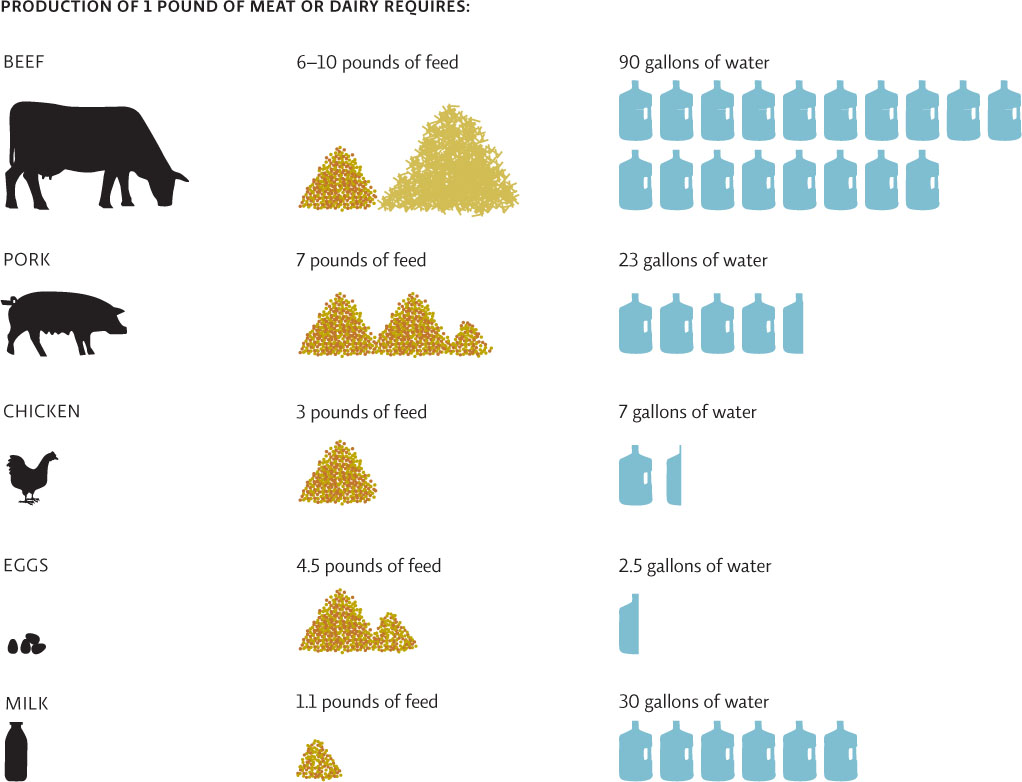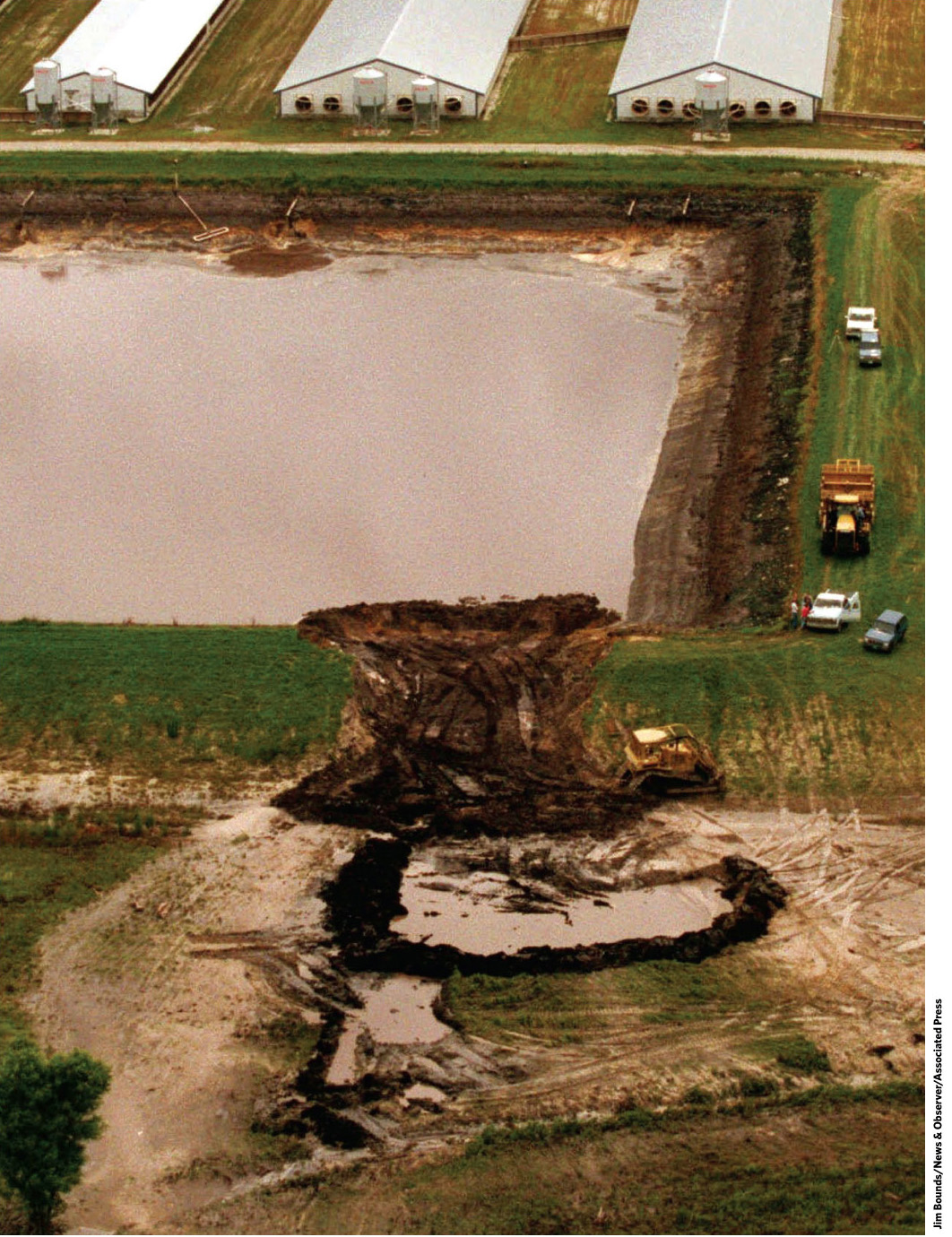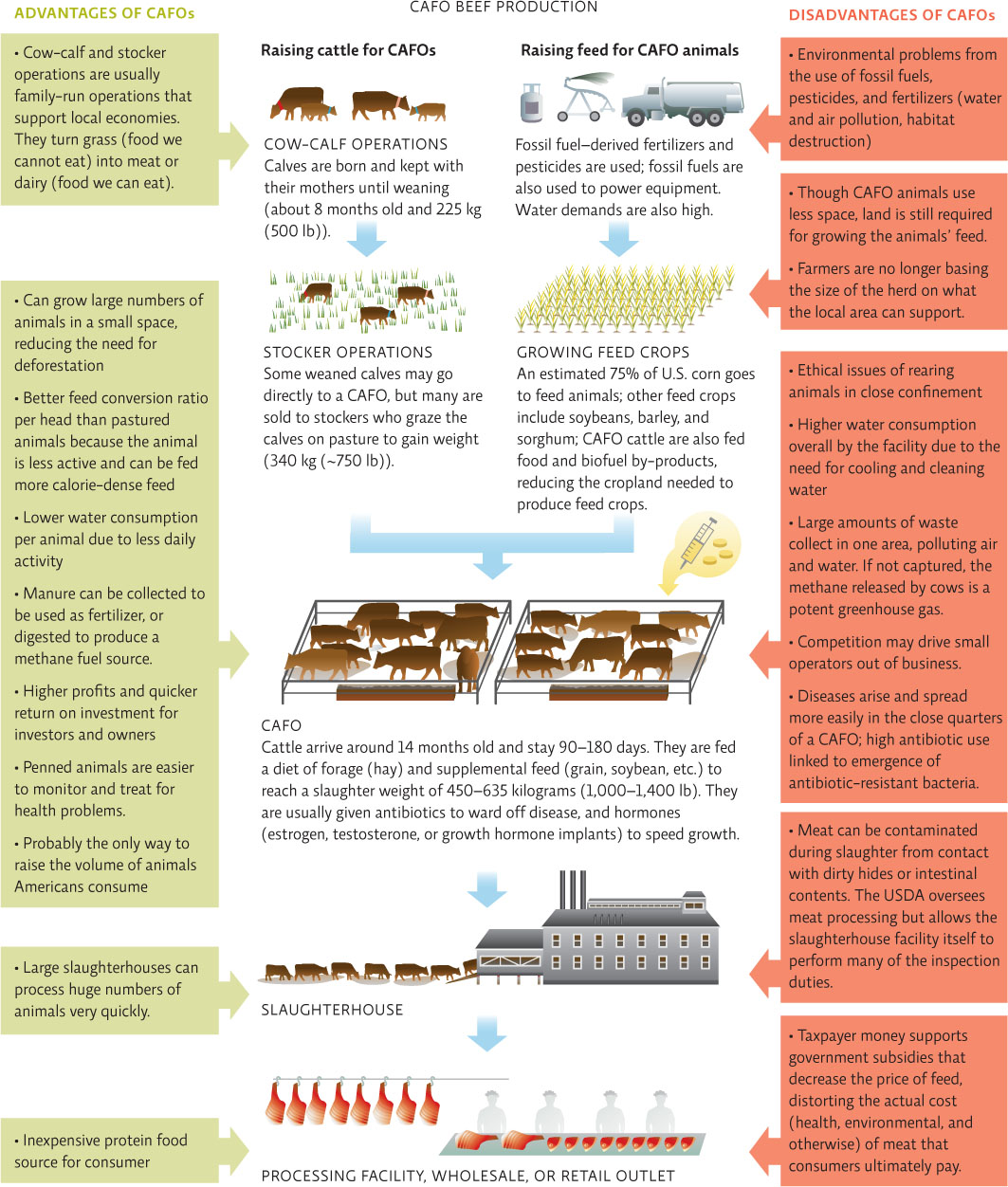CAFOs can raise a large number of animals quickly but incur a huge environmental cost.
In large, long, low-slung gray buildings on the edge of rural Indiana, tens of thousands of cattle stand nearly motionless, crammed together, mooing and occasionally jostling for space. There are no windows, and thus there is no sunlight. They moo and they jostle and by many accounts they spend much of the time standing ankle deep in their own feces. What they don’t do in many cases is go outside. Or walk around.
It’s not just cattle that live this way. Pigs are reared in often tighter quarters, exposed to their own urine and feces. And in chicken CAFOs, birds are raised in such tight quarters that the farmers clip off the ends of their beaks to prevent them from pecking each other to death. Animal rights activists have protested vehemently against the cruelty of such a life, but animal rights are not the priority here. The priority is to get as many animals as possible as fat as possible in as little time as possible. Movement is antithetical to all three. And for cattle, so is a diet of grass.
CAFO cows start their lives on pasture, in cow-calf operations. Once delivered to the pens, at around 14 months old, the cattle begin a slow transition from a diet of hay or grass to a diet supplemented with soybeans and grains (including corn, sorghum, and oats). It’s important to do this slowly. Because cattle are not naturally adapted to digesting grain, switching their diets too quickly can make them sick. When done properly, the switch to grain (and the lack of movement) enables the animals to gain about 0.9 kilograms (2 pounds) a day. Even then, they may suffer health problems such as liver abscesses or intestinal tract damage. Animals receive medications to combat these diet-imposed health problems.
Some 70% of the cattle that eventually make their way to American dinner plates are “finished”—meaning they spend the last 3 to 5 months of their lives in buildings or outdoor pens like the ones just described.
There are several advantages to rearing livestock in this way. The biggest one by far is the sheer volume of animals that can be produced. According to the Union of Concerned Scientists, CAFOs now produce more than half of all our animal food, even though they account for just 5% of all animal farms. There are two main reasons for this: First, a large number of animals be grown on relatively little land. In addition, those animals can be “turned around” (brought from birth to market) with amazing speed—just under 2 years, compared with several years for typical pasture-raised cattle. In fact, if there’s one thing both supporters and opponents agree on, it’s this: We’d be hard pressed to produce as much meat and chicken and pork, or to produce it as cheaply as we do now, without these types of operations.
The intense mechanization of feedlot farming means that the animals’ diet and environment can be better controlled than it would be on more traditional open-pasture farms. And because animals are so concentrated and confined, it is possible to harvest their manure and sell it as fertilizer. The amount of land used directly by the animals—and thus the amount of land that must be cleared of natural vegetation or otherwise denuded—is minimized on a CAFO.
But a growing number of critics say that those advantages in space and production volume come at a huge cost to the environment and to human health.
KEY CONCEPT 30.3
Some animals are more efficient than others at converting the food and water they consume into food we can consume.
As environmentalists are quick to point out, the grain and soybean used to feed all those livestock would feed far more people than the meat we harvest from the animals actually does. The reason for this has to do with the feed conversion ratio—how quickly and efficiently any given animal converts the food it eats into body mass. Cattle have a high feed conversion ratio, meaning it takes a lot of feed to produce a gallon of milk and even more to produce a pound of meat. CAFO-reared cattle do have a better feed conversion ratio than do grass-fed cattle; they move around less, gain weight more quickly, and are slaughtered sooner; they burn fewer calories in day-to-day maintenance because they are less active and don’t live as long. But they still have a worse feed conversion ratio than either chickens or pigs.
feed conversion ratio
The amount of edible food that is produced per unit of feed input.
These days, nearly 75% of the corn produced in the United States is used as animal feed—and about half of that goes to cattle. All told, that’s about 10 billion bushels of corn, which requires roughly 30 million hectares (about 80 million acres), or one-quarter of all U.S. cropland, to grow. Dedicating so much farmland to grow animal feed offsets or even surpasses the land area saved by confining animals to smaller spaces. Though the cattle themselves do not require as much land for grazing, by some estimates, it costs us between 7 and 14 hectares (17–34 acres) worth of grain crop for every ton of beef (about four head of cattle) we produce. The food that could be grown on this land would feed 5–10 times more people than the beef it would produce could feed.
These days, nearly 75% of the corn produced in the United States is used as animal feed—and about half of that goes to cattle.
The industrial methods used to raise those feed crops come at a hefty ecological cost that includes habitat loss, water depletion, pollution from field runoff and pesticide application, and soil erosion from cultivated fields (see Chapter 17). The water footprint of raising animals this way is also high: We spend, for example, 26 liters of water to produce a pound of chicken, 87 liters for a pound of pork, and a whopping 340 liters for a pound of beef. Much of the water used in a CAFO goes to manure handling. INFOGRAPHIC 30.3
The feed conversion ratio shows how much edible food is produced from the food an animal is fed. We never see 100% conversion because the animal has already used most of the energy it has consumed in its life in day-to-day activities; however, some species are better at converting feed to edible food than others. It may also be surprising how much water is needed to produce meat and dairy products; much of that water goes to grow the feed.


In terms of efficiency, which is the “better” feed conversion ratio: a higher number or a lower one?
The lower number is better – this means less food is needed to produce one pound of meat or dairy. In other words, the animal with the lower feed conversion rate can convert more of its own food to edible food products for us than an animal with a higher feed conversion rate.
water footprint
The amount of water consumed by a given group (that is, person or population) or for a process (such as raising livestock).
Containing both the water and the manure is one of the biggest challenges CAFO operators face. Some manure is collected and sprayed onto cropland, where it acts as a natural fertilizer (though this is risky because the manure can carry pathogens). But most CAFOs produce more manure than can be applied to local fields. Indeed, some of the largest CAFOs produce more waste than a large U.S. city.
Where does it all go? To multi-acre reservoirs known as lagoons. Ebner (from Purdue University) compares these to human wastewater facilities and says that they allow for microbial digestion of the waste. But critics say that they are the equivalent of a city with a population of 3 million people (that’s about twice as large as Philadelphia) sending all of its raw sewage to a giant open pit. As the waste breaks down, a variety of gases are produced. When the waste is stirred or agitated, a practice commonly performed before the lagoon is emptied, enough hydrogen sulfide gas can be released to reach toxic levels for nearby workers or animals. If the lining of a lagoon cracks, or if a lagoon pump springs a leak, the results can be disastrous.

In 1995, when a manure lagoon at a swine operation in North Carolina failed, 95 million liters of manure went racing into the nearby New River, killing 10 million fish and closing nearby coastal areas to shellfishing. Area residents described the stench of manure, urine, and rotting fish—which they endured for weeks—as almost unbearable. In 2007, North Carolina banned the construction of new lagoons at swine CAFOs, favoring technical solutions that process the manure to remove the nutrients like phosphorus and nitrogen that could contaminate nearby water bodies and even collect methane from the waste for electricity generation. These technical solutions, proponents say, can significantly reduce the potential for water pollution and turn waste material into a useful resource.
According to Shalamar Armstrong of Purdue University, along with the Indiana Department of Environmental Management, E. coli contamination from feedlots has impaired more than 9,600 kilometers (6,000 miles) of river. In addition, both nitrogen and phosphorus from manure spills or runoff can cause cultural eutrophication (see Chapter 15 and Chapter 17) in lakes, streams, and coastal areas that can result in hypoxic waters. High nitrate levels are also directly toxic both to humans and to aquatic life. Groundwater can be affected, too; wells close to CAFOs are more likely to be contaminated with dangerous levels of nitrate than those further away.
Air pollution is another big problem; not only are pollutants released at every stage of production, but so many hooves trampling the dirt creates dust, which in dry weather can reach high enough concentrations to compromise human and animal health alike. Odor is a problem, too. “It’s like a city’s worth of poop,” says Kim Ferraro, an environmental lawyer who specializes in CAFO-related issues and who is representing one Indiana family in a lawsuit against a neighboring CAFO operator. “My clients were literally driven from their homes by the stench.”
Another environmental concern is the high carbon footprint of CAFOs. Clearing so much land to grow feed crops reduces the amount of carbon that would normally be sequestered by natural vegetation through photosynthesis. Also, fertilizer, equipment, and livestock all emit greenhouse gases, atmospheric gases that trap heat and contribute to climate change. According to the UN Food and Agriculture Organization (FAO), livestock is responsible for around 14.5% of all anthropogenic greenhouse gas emissions, globally—the majority of it coming from beef and dairy cattle production. (For comparison, transportation is responsible for about 14% of all anthropogenic emissions.) “It’s true that CAFOs take up less space than other types of animal operations,” says Ferraro. “But once you factor in the hectares of grain crop it takes to raise them in this way, it’s obvious that they’re still contributing heavily to greenhouse gas emissions.”
carbon footprint
The amount of carbon dioxide (CO2) or other greenhouse gas released by an action; a concern because it contributes to climate change.
KEY CONCEPT 30.4
CAFOs can raise many more animals than traditional methods but negatively affect the health of the animals and produce substantial environmental impacts.
Disease spreads quickly among living creatures cramped into close and unsanitary quarters; that’s as true of other animals as it is of humans. So many animals and so much feces cannot help but attract flies and other insects, which are bothersome at best and disease transmitters at worst. CAFO farmers are known to dispense large doses of antibiotics in the animals’ water and food to combat these vulnerabilities. In fact, 80% of antibiotic use in the United States goes to livestock. While there is no danger of the antibiotics themselves being passed on to consumers in the animals’ meat, such prolific use of these valuable medications has contributed to the rise of antibiotic-resistant bacteria, which can and do make their way to human hosts through the water supply, through other food sources, and through the meat itself. INFOGRAPHIC 30.4
Beef that comes from CAFOs starts on smaller family farms in cow-calf operations. From birth to slaughterhouse takes about 18 months, shaving 2 or more years off the time it would take to raise a cow to the same size on pasture alone. The advantages of CAFOs are mainly economic, whereas the disadvantages include environmental, health, and ethical concerns.


Which of the disadvantages of CAFOs do you think would be the easiest to address? Which do you think would be the hardest to address? Explain.
Answers will vary. Problems with technical solutions may be the easiest to solve such as better handling of waste to prevent pollution or better disease prevention by keeping the area cleaner (remove manure more frequently; separate out sick animals as soon as possible; clean animals or carcasses thoroughly before slaughter). The ecological strain of raising more animals than is locally sustainable may be harder to address --- there are limits to how productive a given land area can be or how much water is available.
The presence of 157 is not a result of antibiotic resistance, but it is likely a matter of too many animals in too little space. Across the country, scientists and CAFO operators are working to mitigate its spread.